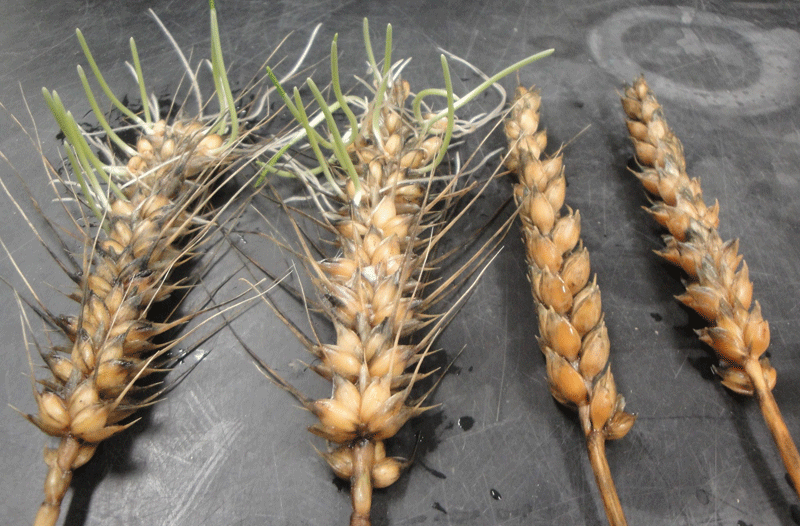Sprout resistant wheat
THE RIGHT GENES
WITH A FULLY sequenced wheat genome still another two years away, wheat breeders don’t yet have a full picture of all the genomes they are dealing with — and until recently, the root causes of pre-harvest sprouting were a bit of a mystery among geneticists.

At McGill University in Montreal, Quebec, researchers in Dr. Jaswinder Singh’s laboratory have found that DNA markers are not the only factor worth considering when determining if a wheat or barley variety may be prone to sprouting.
At a genetic level, seed dormancy is a very complex trait that reacts to the surrounding environment in ways scientists have not always been able to predict. Wheat breeders know what genes that trigger sprouting look like and can choose to discard varieties which have these genes. However, one of the researchers, PhD student Surinder Singh, says there is a problem with this.
“The genes for germination are the same which trigger sprouting in the spike,” he says.
Jaswinder Singh elaborates further by saying that it is only the state of the gene that affects its expression. The difference between a variety that is highly prone to sprouting and one that germinates quickly in the spring is only due to the natural variation present in the gene’s expression.
Under the guidance of Jaswinder Singh, the team at McGill looked a little closer at one gene they knew contributed to this phenomenon, to try to discover how it really worked.
“We found that the gene was differently expressed in susceptible and resistant varieties,” Surinder Singh says. “When we studied the mechanism of the details we found that it is controlled through epigenetics.”
UNDERSTANDING EPIGENETICS
Epigenetics is the study of gene regulation. Genes can be part of DNA sequences which never produce the effects that researchers would expect them to.
“We sometimes call the gene we found a switch,” explains Surinder Singh, “which, when switched on and off, can control other genetic factors.”
The first step in making the discovery was to compare 10 well known Western Canadian varieties. Jaswinder Singh says they chose tolerant varieties and compared their DNA against more susceptible varieties.
The gene family the Argonaute protein belongs to is known to researchers as a key family because it provides a pathway to regulating important genes. More importantly, Jaswinder Singh says, “we have identified why the expression of Argonaute is actually affecting the mechanism.”
Somewhat like a motion sensor, if Argonaute is present, the genes that cause pre-harvest sprouting will come on in high moisture environments.
Both researchers explain that testing for pre-harvest sprouting resistance is usually a laborious process that involves artificial weathering, field trials, and a lot of enzyme assessments.
“But we just take the DNA, we don’t even need to grow the plant to maturity,” Surinder Singh says. “We just grow the plant for five days, take a leaf, take out the DNA, and you get to know in two days whether they are the resistant variety you want to sow.”
Jaswinder Singh also points out that in addition to assessing Argonaute at the genetic level, they also found good results in analyzing the molecular composition of the protein.
“We identified that if the gene has that particular element, its size is larger,” he says.
That means the gene appears visually smaller, allowing a breeder to guess right away that it is more likely to be susceptible to pre-harvest sprouting.
“The other good news is, this is absolutely heritable,” he adds — which means anytime both parents have the larger version of the molecule, any of the progeny they produce should be more resistant to sprouting too.
Surinder Singh believes the beauty of the entire discovery is the consistency it offers breeders. “These markers which we used in our study, they’re very accurate,” he says. “It’s kind of a foolproof concept.”
BREEDER’S PERSPECTIVE
Dr. Harpinder Randhawa says this new understanding of the role played by epigenetics in pre-harvest sprouting is very useful to wheat breeders.
“We know from past studies that there are pre-harvest sprouting genes,” he says. “What’s novel about this study is they found out how those genes behave, and how some genes are turned on, some genes are turned off.”
Randhawa says having the ability to select for or against these switches with the help of DNA markers is a powerful breeding tool, especially compared to the traditional breeding process.
“Selection only works when there’s a lot of pressure from different stresses, and if you want to select for disease resistance, you’re going to make sure that there is a lot of disease severity in your nursery — then you pick the survivor,” he explains while noting it is not a perfect system because it doesn’t always produce a clear winner to move forward with.
But if you have the DNA marker, that saves a lot of time and increases precision. Or at least it will, once the process has been fully validated.
“It’s like any technology,” Randhawa explains, “you have the prototypes and then you improve on them.”
Randhawa says more research is needed to advance the work that was done by the McGill research team. Their conclusions need to be applied to a much broader selection of international wheat varieties before everyone can be confident that there are no coincidences at play. The advancement of a selection tool is also going to be prohibited by cost until it is widely adopted, so a number of organizations will have to wait until it’s a tool they can afford to use. •

















